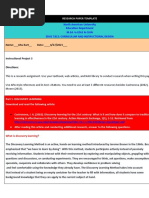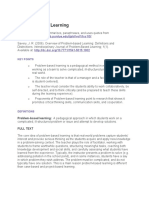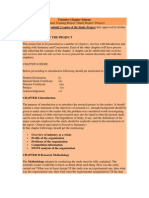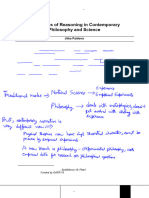Educ 5312-Research Paper Template 1 1
Educ 5312-Research Paper Template 1 1
Uploaded by
api-490634750Copyright:
Available Formats
Educ 5312-Research Paper Template 1 1
Educ 5312-Research Paper Template 1 1
Uploaded by
api-490634750Original Title
Copyright
Available Formats
Share this document
Did you find this document useful?
Is this content inappropriate?
Copyright:
Available Formats
Educ 5312-Research Paper Template 1 1
Educ 5312-Research Paper Template 1 1
Uploaded by
api-490634750Copyright:
Available Formats
RESEARCH PAPER TEMPLATE
North American University
Education Department
M.Ed. in EDLE & CUIN
EDUC 5312: CURRICULUM AND INSTRUCTIONAL DESIGN
Name: Betulnursen Ulusoy Date: 4/17/202
Instructional Project 3
Directions:
This is a research assignment. Use your textbook, web articles, and NAU library to conduct resear
when writing this paper.
Use APA style references and in-text- citations. You need to use at least 3 different resources
besides Castronova (2002), and Moore (2015).
Part 1. DISCOVERY LEARNING:
Download and read the following article:
Castronova, J. A. (2002). Discovery learning for the 21st century: What is it and how
does it compare to traditional learning in effectiveness in the 21st century. Action
Research Exchange, 1(1), 1-12. Retrieved from
http://citeseerx.ist.psu.edu/viewdoc/download?
doi=10.1.1.594.6363&rep=rep1&type=pdf
After reading this article and conducting additional research, answer to the following
questions.
What is discovery learning?
Discovery learning is an approach to learning by particular teaching methods and
strategies. Discovery learning is exploring and problem solving by students. "Discovery learning
encompasses a teaching model and strategies that focus on active, hands-on learning opportunitie
for students" (Dewey, 1916/1997; Piaget, 1954, 1973). Discovery Learning is the learning that take
put within the environment that happens when educating and educating techniques outlined by the
person, the educator, and when such procedures are utilized. This hypothesis energizes
understudies to utilize their instinct, creative energy, and imagination, construct on past experience
and information, and seek for modern information to find truths, relationships, and modern
actualities.
How does this form of teaching compare to traditional, teacher-centered instruction?
Discovery learning provides deeper learning. Through exploring and problem solving,
students create, integrate, and generalize knowledge. Discovery learning is active and
deeper understanding while traditional learning is passive.
What educational theories support the discovery learning model?
Children were naturally motivated to actively learn and that education served to make
more learning possible.
Jean Piaget: Children do not think with the same logic as adults and they are not “empty vessels”
be filled with knowledge, but active builders of knowledge.
John Dewey: It is through social interaction that mental growth is accomplished. Children act as
learning participants rather than as learning receivers.
Lev Vygotsky: A child is talented in solving more complicated problems than would be possible at
particular mental age if the child has parents, teachers, and peers to assist in building the needed
experiences (zone of proximal development).
Jerome S. Bruner: “The outcome of cognitive development is thinking. The intelligent mind creates
from experience "generic coding systems that permit one to go beyond the data to new and possib
fruitful predictions" (Bruner, 1957, p. 234). The aim of education should be to create autonomous
learners (i.e., learning to learn).” (McLeod,2018)
What is the most important thing you discovered about discovery learning?
Discovery learning method motivates students and satisfies their natural curiosity. They find more
and learn more. Incorporating discovery learning in your classroom enables your students to ask
critical questions, conduct their own research, improve their problem-solving skills, and form their
own conclusions. By stepping away from the traditional learning methods, students are given the
possibility to think outside the box.
How can you apply this method to your future classroom?
I believe discovery learning can be applied in all subjects and so in science classes. For example,
atom lessons, students can be given content in which the picture vocabulary explanations are use
instead of directly presenting the target structure. Students then discover the structure of the atom
for themselves. I will make index cards for every student in the class; half with picture vocabulary
about atom content; half with the explanation. I will shuffle the cards and have students find their
appropriate partners by comparing picture vocabulary and explanations on their own. In this way th
teacher’s role becomes guiding students to their own discovery, not giving students the information
on the structure of the atom. I can allow students to work in small groups, conduct researches, and
take them out to the fields and libraries. Give them projects to complete.
Part 2. ADDITIONAL CHAPTERS
Select one of the following chapters to conduct research: Chapter 2, 3, 5 or 12. Revie
the chapter and respond to related questions for that chapter by conducting your ow
research.
Chapter 2- Teaching Diverse Students
1. Teaching all students. Remember that a teacher’s job is to teach all students and assume
an attitude that all students can learn. Research techniques and strategies that can be used
accomplish this task. Sources of information include the library, the Internet, current journal
and recent books.
Teachers must plan carefully to meet the needs of diverse student populations. During
classroom interactions and instructions, teachers must keep the cultural needs of their
diverse student population in mind. Teachers could implement games so that all students
could gain social acceptances of one another and also learn the topics through an effective
and amusing method. Another method is an example of the cooperative learning way: the
Student Teams Achievement Division (STAD). Students would be paired with varied
ethnical diversities, and they would learn together and gain scores based on how they
improve on their test scores. Teachers must identify student's needs, strengths, weaknesse
aspirations, limitations, and deficiencies.
2. Intelligence profile. Evaluate your own intelligence profile according to Gardner. In what
frames of mind (intelligence areas) do you come out strongest?
My intelligence profile is: linguistic, interpersonal, intrapersonal, and naturalist also
spatial.
Chapter 3- Managing Classroom Environment
1. Discipline approaches. Analyze the three approaches to classroom management. Which
approach, if any, do you prefer? Can you put together parts of the different approaches and come
with an eclectic approach that you think would work for you? Can you identify some basic concept
that appear to be true of all three approaches?
2. Causes of misbehavior. Think back over the classes you have attended in which there have
been disciplinary incidents. List the possible causes for any such misbehavior. How might knowled
of the causes of these incidents influence a teacher’s actions? Some behavior problems are teach
created and some are student centered. Can you think of examples?
Chapter 5- Using Classroom Technology
1. How does technology enhance the teacher’s ability to plan instruction? Use one of the available
search engines to explore the web for technological tools such as lesson planning software,
worksheets and puzzle tools, poster and bulletin board production tools, and time management too
that will assist you in planning. Share your findings with your class.
2. Technology offers tools that can help students learn. To what technology should students have
access? Do you have any educational concerns about the use of these technologies in schools? If
so, what are they? If not, why not?
Chapter 12- Teaching Effective Thinking Strategies
1. Teaching methods. What teaching methods and procedures can be used to improve students’
critical thinking abilities? Creative thinking abilities?
2. Thinking. What type of thinking is emphasized in most schools? Is critical thinking rewarded?
Creative thinking? Is school success based on students’ ability to think critically? Creatively?
3. The environment. What type of classroom environment would be conducive to developing crit
thinking? Creative thinking? What problems can you foresee in establishing this environment?
Part 3. REFERENCES:
Cite at least 5 References in APA.
You need to use at least 3 different resources besides Castronova (2002), and Moore
(2015).
You may use http://www.citationmachine.net/apa/cite-a-journal for citing your sourc
in APA style.
References:
1.Castronova, J. A. (2002). Discovery learning for the 21st century: What is it and how does it compare to
traditional learning in effectiveness in the 21st century. Action Research Exchange, 1(1), 1-12.
http://www.myenglishpages.com/files/1282044031.pdf
2.Moore, K. (2015). Effective instructional strategies: From theory to practice (4th ed.). Los Angeles: Sage.
3.Moles, O. C. (1990). Student discipline strategies: research and practice. Albany, NY:
State University of New York Press.
4.Moyer, P.S. Educational Studies in Mathematics (2001) 47: 175. doi:10.1023/A:1014596316942
5.Moyer, P. S., Bolyard, J. J., & Spikell, M. A. (2002, February). What Are Virtual
Manipulatives? Teaching Children Mathematics. Retrieved June 9, 2017, from
http://courses.edtechleaders.org/documents/elemmath/manipulatives.pdf
You might also like
- Researcher Positionality - A Consideration of Its Influence and Place in ResearchDocument29 pagesResearcher Positionality - A Consideration of Its Influence and Place in Researchatharhussain50% (2)
- Research Psychology (PSYC7324) : Lecturer: Naledi RabaDocument41 pagesResearch Psychology (PSYC7324) : Lecturer: Naledi Rabaestoc19No ratings yet
- DR Tito M. Cabili's Thesis FormatDocument17 pagesDR Tito M. Cabili's Thesis FormatCorong RoemarNo ratings yet
- Davidson, Donald - Knowing One's Own MindDocument19 pagesDavidson, Donald - Knowing One's Own Mindgalen_mitchell100% (1)
- Instructional Plan DepedDocument9 pagesInstructional Plan Depedorito rosalie83% (6)
- Instructional Project 3Document3 pagesInstructional Project 3api-290589017No ratings yet
- Pedagogies for Student-Centered Learning: Online and On-GoundFrom EverandPedagogies for Student-Centered Learning: Online and On-GoundRating: 3.5 out of 5 stars3.5/5 (3)
- Mind Wandering During Lectures I: Changes in Rates Across An Entire Semester Wammes Et Al., STLP1Document20 pagesMind Wandering During Lectures I: Changes in Rates Across An Entire Semester Wammes Et Al., STLP1Elena SinelNo ratings yet
- Guide To Bloom's TaxonomyDocument2 pagesGuide To Bloom's TaxonomyVenkatesh KumarNo ratings yet
- Dewey Between Hegel and DarwinDocument17 pagesDewey Between Hegel and DarwinVitaly KiryushchenkoNo ratings yet
- Educ 5312Document4 pagesEduc 5312api-667210761No ratings yet
- Research Paper CastranovaDocument6 pagesResearch Paper Castranovaapi-550304549No ratings yet
- Educ 5312Document5 pagesEduc 5312api-708665018No ratings yet
- Educ 5312Document4 pagesEduc 5312api-746054314No ratings yet
- Educ 5312-Research Paper Template 3 3Document4 pagesEduc 5312-Research Paper Template 3 3api-357888670No ratings yet
- Educ 5312-Instructional Project 3 - Research Assignment Ver5Document5 pagesEduc 5312-Instructional Project 3 - Research Assignment Ver5api-534533713No ratings yet
- InstructIonal Project 3 Research PaperDocument6 pagesInstructIonal Project 3 Research Paperapi-459665908No ratings yet
- Project 3 1Document4 pagesProject 3 1api-668037006No ratings yet
- Educ 5312-Research Paper WeeblyDocument4 pagesEduc 5312-Research Paper Weeblyapi-290266366No ratings yet
- Educ 5312-Research Paper - Samir AhmadovDocument4 pagesEduc 5312-Research Paper - Samir Ahmadovapi-302415858No ratings yet
- Educ 5312Document7 pagesEduc 5312api-668204861No ratings yet
- Educ 5312Document6 pagesEduc 5312api-555121198No ratings yet
- Educ 5312 MkaraogluresearchpaperDocument5 pagesEduc 5312 Mkaraogluresearchpaperapi-464635238No ratings yet
- Educ 5312Document4 pagesEduc 5312api-709524974No ratings yet
- Educ 5312-Resea 3Document7 pagesEduc 5312-Resea 3api-290458252No ratings yet
- Instructional Project 3 - Research Assignment Extra ChaptersDocument8 pagesInstructional Project 3 - Research Assignment Extra Chaptersapi-534819778No ratings yet
- Research Paper Template-Ahu Kurt 1Document4 pagesResearch Paper Template-Ahu Kurt 1api-534583781No ratings yet
- Instructional Project 3 - Educ 5312-Research Paper-Ridwan SumitroDocument6 pagesInstructional Project 3 - Educ 5312-Research Paper-Ridwan Sumitroapi-548651412No ratings yet
- Educ 5312-Research Paper Ahmet UnluDocument3 pagesEduc 5312-Research Paper Ahmet Unluapi-316879898No ratings yet
- Educ 5312-Muhammed Bilgin Research Paper TemplateDocument5 pagesEduc 5312-Muhammed Bilgin Research Paper Templateapi-340945831No ratings yet
- Educ 5312-Research Paper Template 2 1Document4 pagesEduc 5312-Research Paper Template 2 1api-317138259No ratings yet
- Ip 3Document5 pagesIp 3api-317212800No ratings yet
- Educ 5312-Research Paper Abdulkadir CiplakDocument7 pagesEduc 5312-Research Paper Abdulkadir Ciplakapi-322522017No ratings yet
- Educ 5312-Research Paper-Instructional Project 3Document5 pagesEduc 5312-Research Paper-Instructional Project 3api-349575445No ratings yet
- Kubra Shanol Erden Educ5312Document4 pagesKubra Shanol Erden Educ5312api-708891654No ratings yet
- Educ 5312Document4 pagesEduc 5312api-584550604No ratings yet
- Educ5312-Researchpapertemplate-Kubra AkbayDocument4 pagesEduc5312-Researchpapertemplate-Kubra Akbayapi-290792376No ratings yet
- Educ 5312Document7 pagesEduc 5312api-582677663No ratings yet
- Aktas-Project 3Document5 pagesAktas-Project 3api-242938257No ratings yet
- Bilek Halim Educ 5312-Research PaperDocument6 pagesBilek Halim Educ 5312-Research Paperapi-322653911No ratings yet
- Educ 5312-Research Paper TemplateDocument5 pagesEduc 5312-Research Paper Templateapi-340989456No ratings yet
- Educ 5312-Research Paper Template 1 1Document8 pagesEduc 5312-Research Paper Template 1 1api-357803051No ratings yet
- Educ 5312-Research Paper Mustafa Citci 1Document4 pagesEduc 5312-Research Paper Mustafa Citci 1api-302328402No ratings yet
- Guide To Active LearningDocument17 pagesGuide To Active LearningAdela Fontana Di TreviNo ratings yet
- Educ 5312-Research Paper TemplateDocument6 pagesEduc 5312-Research Paper Templateapi-357822494No ratings yet
- Prof EdDocument3 pagesProf EdJoanne May EsparasNo ratings yet
- 1bruners Spiral Curriculum For Teaching & LearningDocument7 pages1bruners Spiral Curriculum For Teaching & LearningNohaNo ratings yet
- EDUC5210 Written Assignment Unit 3Document6 pagesEDUC5210 Written Assignment Unit 3Olaniyi IsaacNo ratings yet
- Educ 5312-Research Paper Template 4Document5 pagesEduc 5312-Research Paper Template 4api-302329818No ratings yet
- Thesis Chapter 1Document10 pagesThesis Chapter 1Maria Camille Villanueva SantiagoNo ratings yet
- Problem-Based LearningDocument13 pagesProblem-Based LearningEstela BenegildoNo ratings yet
- Research Paper (Esic, Lapat)Document9 pagesResearch Paper (Esic, Lapat)Lui Harris S. CatayaoNo ratings yet
- UNit 502 Answer SheetDocument28 pagesUNit 502 Answer SheetRizvi RidowanNo ratings yet
- Kristel Joy Carmona - Module 5 - EDUC 313BDocument6 pagesKristel Joy Carmona - Module 5 - EDUC 313BKristel Joy Adorador CarmonaNo ratings yet
- Instructionalproject 21Document6 pagesInstructionalproject 21api-290533089No ratings yet
- Is Process-Oriented Guided-Inquiry Learning (Pogil) Suitable As A Teaching Method in Thailands Higher EducationDocument9 pagesIs Process-Oriented Guided-Inquiry Learning (Pogil) Suitable As A Teaching Method in Thailands Higher EducationWahab AbdullahNo ratings yet
- (Sophia Bianca A. Duag) Annotated Bibliography For Individualized Teaching StrategyDocument6 pages(Sophia Bianca A. Duag) Annotated Bibliography For Individualized Teaching StrategySophia BiancaNo ratings yet
- Concept Based Learning - Final Essay-1Document45 pagesConcept Based Learning - Final Essay-1RP17 CE21No ratings yet
- Module Two Teaching in Elementary Science: Agusan Del Sur College Inc. Bayugan CityDocument7 pagesModule Two Teaching in Elementary Science: Agusan Del Sur College Inc. Bayugan CityJames Revin Gulay IINo ratings yet
- Final Thesis Merrylle AutosavedDocument27 pagesFinal Thesis Merrylle AutosavedJumaryse MarabutNo ratings yet
- Learning Environments and Implications in A 5th Grade Classroom.Document5 pagesLearning Environments and Implications in A 5th Grade Classroom.Luisa González VarelaNo ratings yet
- SSRN-id3398151 2Document5 pagesSSRN-id3398151 2hoangkobeo2002No ratings yet
- ConstructivismDocument6 pagesConstructivismZarah HonradeNo ratings yet
- ConstructivismDocument17 pagesConstructivismJennifer DizonNo ratings yet
- Activity 2-Feb 25Document3 pagesActivity 2-Feb 25Mhelanie T. BalocNo ratings yet
- Chapter IDocument17 pagesChapter IFleur De Liz CredoNo ratings yet
- Creative Thinking and Student Centred Learning in UG Classroom: A Small SurveyDocument6 pagesCreative Thinking and Student Centred Learning in UG Classroom: A Small SurveyAna BeNo ratings yet
- Soad 9206 Lecture 3 FloDocument17 pagesSoad 9206 Lecture 3 FloSusan PradeepNo ratings yet
- Opinion Essay Structure - StudentDocument10 pagesOpinion Essay Structure - StudentasadNo ratings yet
- 2 ConstructivismDocument1 page2 ConstructivismShyamal Kanti DasNo ratings yet
- Tentative Chapter SchemeDocument3 pagesTentative Chapter SchemeDigvijay SinghNo ratings yet
- Deviant Behavior Quiz 2Document2 pagesDeviant Behavior Quiz 2api-258581956No ratings yet
- Definition of Deductive ReasoningDocument2 pagesDefinition of Deductive ReasoningMary Rose TorinoNo ratings yet
- Mindreading - 3. Objections, Replies, and Philosophical ImplicationsDocument10 pagesMindreading - 3. Objections, Replies, and Philosophical ImplicationsAdolfo Ayllón RodríguezNo ratings yet
- Deductive Reasoning Vs Inductive ReasoningDocument2 pagesDeductive Reasoning Vs Inductive ReasoningMd AzimNo ratings yet
- Chapter 1 - Intro To ResearchDocument42 pagesChapter 1 - Intro To ResearchMar LonNo ratings yet
- Background of Logic: Compiled By: Dr. Clive Alvyn OconDocument12 pagesBackground of Logic: Compiled By: Dr. Clive Alvyn OconFrederick GaorNo ratings yet
- Words To Be Used As Per AICTEDocument2 pagesWords To Be Used As Per AICTELakshmi Ganesh Sudikonda100% (1)
- Willem de Jong, The Analytic-Synthetic Distinction and The Classical Model of Sciencie, Kant, Bolzano and Frege PDFDocument25 pagesWillem de Jong, The Analytic-Synthetic Distinction and The Classical Model of Sciencie, Kant, Bolzano and Frege PDFCAMILO ALEXIS MATIAS QUILAPANNo ratings yet
- Content of Science CurriculumDocument30 pagesContent of Science CurriculumCarlo ManguilNo ratings yet
- How To Write A Research ReportDocument3 pagesHow To Write A Research ReportËÐwïn Torres100% (2)
- 6 Ways Erikson's Theory Is HelpfulDocument3 pages6 Ways Erikson's Theory Is Helpfulxx100% (2)
- Artificial Intelligence A Modern Approach - 1Document11 pagesArtificial Intelligence A Modern Approach - 1ornek50% (2)
- Theory of Mind - Edited 1Document7 pagesTheory of Mind - Edited 1muriungiNo ratings yet
- (Unacademy AIMT - 5) New Styles of Reasoning in Contemporary Philosophy and ScienceDocument12 pages(Unacademy AIMT - 5) New Styles of Reasoning in Contemporary Philosophy and ScienceJannu AkashNo ratings yet
- Arabic Translation in The Light of Speech Act Theory and Grice Maxims (Pragmatic Equivalence in Translation of Lenin Al-Ramly's in Plain Arabic)Document2 pagesArabic Translation in The Light of Speech Act Theory and Grice Maxims (Pragmatic Equivalence in Translation of Lenin Al-Ramly's in Plain Arabic)businessdatabasesNo ratings yet
- Lesson 8Document53 pagesLesson 8mumtazNo ratings yet
- Writing The Research Report: Jose Rizal UniversityDocument29 pagesWriting The Research Report: Jose Rizal UniversityBianca ClementeNo ratings yet
- Intellectual Revolutions - Overview and Activity 3Document9 pagesIntellectual Revolutions - Overview and Activity 3Kristel Alexis CelizNo ratings yet

























































































